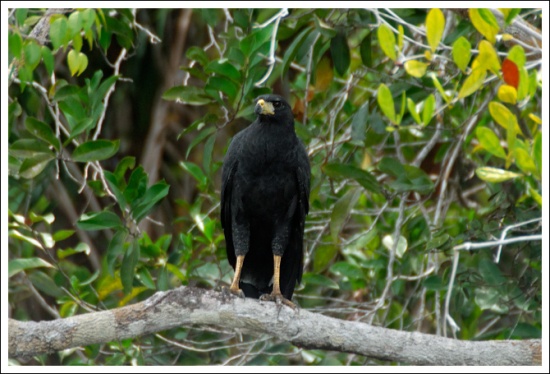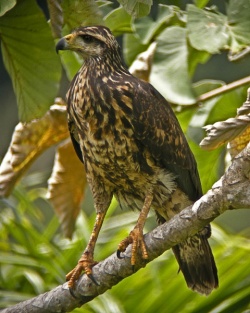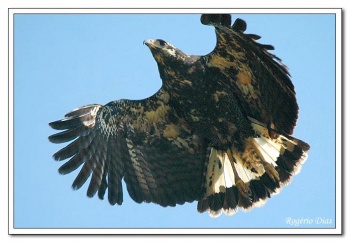(Flight picture of adult. References update) |
|||
| Line 2: | Line 2: | ||
;[[:Category:Buteogallus|Buteogallus]] urubitinga | ;[[:Category:Buteogallus|Buteogallus]] urubitinga | ||
==Identification== | ==Identification== | ||
| − | 51–64 cm<br /> | + | 51–64 cm (20-25 in)<br /> |
Almost entirely black with white on the base and the tip of the tail and with yellow legs and [[Topography#Heads|cere]]. | Almost entirely black with white on the base and the tip of the tail and with yellow legs and [[Topography#Heads|cere]]. | ||
| − | + | ====Variations==== | |
| − | |||
[[Image:Great Black-Hawk 124es.jpg|thumb|250px|right|Immature<br />Photo by {{user|Dave+B+Smith|Dave B Smith}}<br />[[Tobago]], March 2011]] | [[Image:Great Black-Hawk 124es.jpg|thumb|250px|right|Immature<br />Photo by {{user|Dave+B+Smith|Dave B Smith}}<br />[[Tobago]], March 2011]] | ||
| + | Extent of white on tail and color of [[Topography#Heads|lores]] is variable; subspecies ''ridgwayi'' has two white bands on the tail, of which the upper is narrow and often concealed, and slaty lores. This subspecies also often shows some white barring on thighs. | ||
====Similar species==== | ====Similar species==== | ||
| Line 20: | Line 20: | ||
*''B. u. urubitinga'': | *''B. u. urubitinga'': | ||
:*Eastern Panama through [[South America]] to northern [[Argentina]] | :*Eastern Panama through [[South America]] to northern [[Argentina]] | ||
| + | [[Image:44584gavi oni.jpg|thumb|350px|right|Juvenile<br />Photo by '''[http://www.birdforum.net/member.php?u=44584 Rogerio Araújo Dias]'''<br />Brasília, Brazil]] | ||
==Habitat== | ==Habitat== | ||
Habitats from open country to forest but is normally to be seen near water. | Habitats from open country to forest but is normally to be seen near water. | ||
| − | + | ||
==Behaviour== | ==Behaviour== | ||
====Diet==== | ====Diet==== | ||
| − | A wide variety of prey, including birds, rodents, land crabs, frogs and fish. They | + | [[Image:Great Black Hawk2.jpg|thumb|350px|right|Subspecies ''urubitinga'' <br />Photo by {{user|Stanley+Jones|Stanley Jones}}<br />Puerto Jofre, Mato Grosso, [[Brazil]], August 2015]] |
| + | A wide variety of prey, including birds, rodents, land crabs, frogs and fish. They are also known to eat fruit. | ||
==References== | ==References== | ||
| − | #{{Ref- | + | #{{Ref-Clements6thAug15}}#Handbook of the Birds of the World Alive (retrieved July 2014) |
{{ref}} | {{ref}} | ||
==External Links== | ==External Links== | ||
Revision as of 22:09, 4 January 2016
- Buteogallus urubitinga
Identification
51–64 cm (20-25 in)
Almost entirely black with white on the base and the tip of the tail and with yellow legs and cere.
Variations
Extent of white on tail and color of lores is variable; subspecies ridgwayi has two white bands on the tail, of which the upper is narrow and often concealed, and slaty lores. This subspecies also often shows some white barring on thighs.
Similar species
Compare with Common Black Hawk and the rare Solitary Eagle
Distribution
Central and South America: found from Mexico to Bolivia, Argentina, and Uruguay.
Taxonomy
Subspecies
There are two subspecies[1]:
- B. u. ridgwayi:
- B. u. urubitinga:
- Eastern Panama through South America to northern Argentina
Habitat
Habitats from open country to forest but is normally to be seen near water.
Behaviour
Diet
A wide variety of prey, including birds, rodents, land crabs, frogs and fish. They are also known to eat fruit.
References
- Clements, J. F., T. S. Schulenberg, M. J. Iliff, D. Roberson, T. A. Fredericks, B. L. Sullivan, and C. L. Wood. 2015. The eBird/Clements checklist of birds of the world: v2015, with updates to August 2015. Downloaded from http://www.birds.cornell.edu/clementschecklist/download/
- Handbook of the Birds of the World Alive (retrieved July 2014)
Recommended Citation
- BirdForum Opus contributors. (2024) Great Black Hawk. In: BirdForum, the forum for wild birds and birding. Retrieved 26 April 2024 from https://www.birdforum.net/opus/Great_Black_Hawk
External Links







